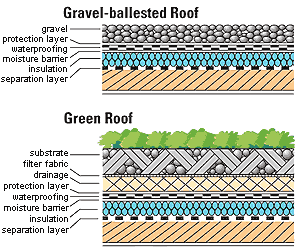 An alternative to your traditional roofing materials is a “green roof”, or a rooftop garden. The surface temperature of a vegetated roof is able to be cooler than the surrounding air temperatures unlike that of a traditional roof surface can be up-to 90°F (50°C) hotter. You can not only improve your energy efficiency but add more greenery to your environment, take a look at the green roof on City Hall of Atlanta Georgia.
An alternative to your traditional roofing materials is a “green roof”, or a rooftop garden. The surface temperature of a vegetated roof is able to be cooler than the surrounding air temperatures unlike that of a traditional roof surface can be up-to 90°F (50°C) hotter. You can not only improve your energy efficiency but add more greenery to your environment, take a look at the green roof on City Hall of Atlanta Georgia.
Green roofs are defines as having vegetation and soil, or another growing medium, that is planted over a waterproof material. Some roofs may also include the additional layers of a root barrier, drainage, and/or irrigation system.
The nice thing about green roofs is that it can be incorporated into many different types of buildings, such as residences, offices, industrial facilities, and other commercial buildings. they are widely used in Europe for their great storm water management, energy saving ability, and their beauty.
This attractive roofing option can reduce urban heat islands with their provided shade and the release of water from the plants to the surrounding air. Additional benefits include:
- Reduce the load in sewage systems by soak up large amounts of rainwater.
- Absorbing air pollution, store carbon, and they collect airborne particulates.
- Eliminating exposure of the sun’s ultraviolet radiation and daily temperature extremes which will protect the underlying roofing material.
- It can serve as habitats for birds and other small animals.
- Can, help address the growing concerns about urban quality of life.
- Improve the noise reduction from the outside sources.
- Insulate a building from extreme temperatures, especiallyin summer, which helps keep the building interior cool.
 Green roofs can help mitigate storm water runoff. As buildings, pavements, roads, and other impermeable surfaces replace open fields and vegetation, this roofing option can play an important role in storm water management. During storms they can absorb much of the water that would otherwise run off. It is estimated that 3-5 inches of soil or another growing medium can absorb 75% of a rain event of 1/2 inch or less.
Green roofs can help mitigate storm water runoff. As buildings, pavements, roads, and other impermeable surfaces replace open fields and vegetation, this roofing option can play an important role in storm water management. During storms they can absorb much of the water that would otherwise run off. It is estimated that 3-5 inches of soil or another growing medium can absorb 75% of a rain event of 1/2 inch or less.
While absorbing this rainwater it also filters the pollution out of it. This is done by the bacteria and fungi in the root system, utilizing the natural filtering process. This results in nitrogen and phosphorous being broken down and detoxified. Over time this process will only increase as the plants and root system mature on the roof.
Green roofs are available in two types, Intensive Green Roof and Extensive Green Roof.
The Intensive Green Roof is characterized by:
- Minimum soil depth of one foot.
- Can accommodate large trees, shrubs, and well-maintained gardens.
- An additional 80-150 pounds per square foot of load to building structure.
- Regular public access is encouraged and accommodated for.
- Requires extensive maintenance, as with any garden type.
- As with any large container garden it must include a complex irrigation and drainage system.
The Extensive Green Roof is characterized by:
- Only needs 1 to 5 inches of soil depth.
- Is just capable of including any vegetative ground cover and grasses.
- Only adds 12-50 pounds per square foot, depending on soil characteristics and the type of substrate.
- Not designed for public access nor accommodated for.
- Only annual maintenance walks need to fill in bare spots with plants.
- Simple irrigation and drainage systems are used.
The up-front cost of the extensive green roof system starts about $8 per square foot in the U.S.This price includes the preparation work, materials, and installation. A traditional built-up roof can start as low as $1.25 and a cool roof membrane is only $1.50 per square foot.
Since these roofs require more material and labor for installation the price would of course be higher. Also as green roof contractor are at premium, i.e. limited, they are harder to come by. Hopefully, as the demand grows so will the amount of contractors available, and prices should drop.
As with any alternative and energy saving building process the up-front cost cannot tell the whole story. If you take into account your energy savings, the limited damage to your roof substrate and the enjoyment of having your own little patch in an urban area, the cost is relative in the long run.
Pictures courtesy of the EPA.